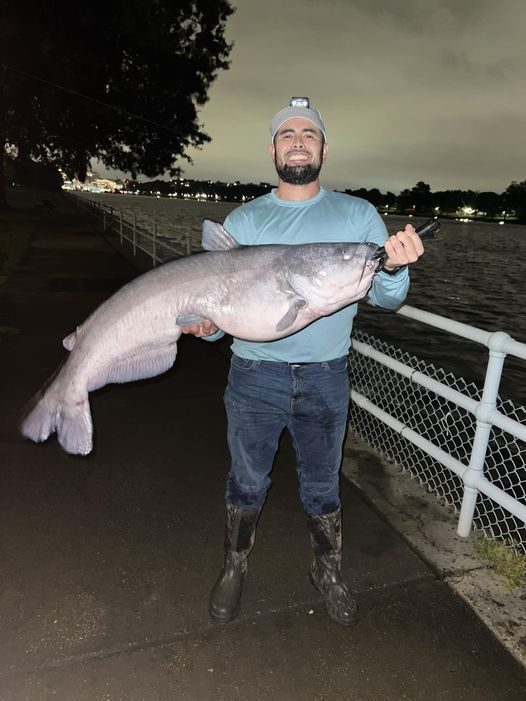October 11th, 2024
Welcome back to the District Fishing Report! Temperatures are cooling down, leaves are changing color, and fishing is getting better all thanks to the arrival of Fall. Most fish are in the midst of a transition from their summer pattern to their fall pattern which will have them feeding for longer periods throughout the day to build up body reserves for the colder months ahead. Our gamefish species such as largemouth bass, smallmouth bass, striped bass, and catfish will be searching for bait along channel edges and near structure offering ample opportunities for anglers. The time of day is less of a factor for fishing this time of year, but the tide still plays an important role. Most fish will look to feed during a moving tide as it carries baitfish through the rivers. Make sure to check a local DC tide chart before your outing to plan for the best time to hit the river. A lot of anglers are finding success throughout the district, so let’s get into the details.
Aquatic Resources Education Center biologists attended Hains Point Community Day last weekend to host a fishing station along the Potomac River side of the park. They reported that the bite was slow to start, but that the catfish started biting better during the late morning hours. Fresh chunks of gizzard shad worked to get the catfish to bite, and anglers reeled in a handful of two- and three-pound fish. They also mentioned that carp anglers seemed to be having better success, and they watched multiple anglers reel in good size common carp. The carp are following the same pattern as most of our other species and will be spending their time fattening up for winter over the next few months. If you want to catch a fish that puts up a big fight, carp may be the fish for you. Common places to fish for them in the district include Anacostia Park, Hains Point, and the Tidal Basin. The bait of choice is known as “pack bait” which can be a combination of corn, cornmeal, panko, Jello, and many other ingredients that get mixed up into a ball that carp enjoy eating. Common carp in the district are known to get over 40 pounds, but you can expect most of them to be in the 10-to-20-pound range. The current DC record carp is 21.35 pounds. There are bigger ones out there, so go catch them!
 |
Angler Devon Addison and a youth angler show off their impressive catch of striped bass.
Largemouth bass are getting active as water temperatures are cooling off. Local angler Devon Addison reports that the bigger largemouth bass have been tricky to figure out lately, but that he has hooked into a few nice ones including a three pounder on a recent trip. Smaller largemouth bass have been much more cooperative, and he said that crankbaits in around 10 feet of water near structure has been very effective. Any of the bridge pilings, marina docks, and pilings in our waters are good areas to search for them. The marinas inside the Washington Channel hold a lot of bass and crappie through the summer and into the fall. If you can get to the channel by boat, there is an abundance of structure to fish that can be very productive. The outgoing tide has been noted as more productive than the incoming, so take that into consideration when planning your trip. Two-to-four-inch paddletails and hard bodied baits will work well to mimic the smaller menhaden, shad, and other baitfish in the river that the bass tend to feed on. Devon also mentioned that the striped bass bite is getting better, and he has landed a few slot sized fish recently on lipless crankbaits. The slot for striped bass in DC is 19 to 24 inches with a creel limit of one fish per person per day. Striped bass can be found along the main channel edge, at the various bridges throughout our waters, and in shallower locations near structure. The mouth of Rock Creek is a great place to fish for striped bass and other gamefish because they stage at the mouth of the creek to ambush bait and smaller fish as they come out. Throwing topwater lures along the seawall in the Tidal Basin and at Hains Point during low light hours will be a good way to catch striped bass cruising the shallows looking for a meal.
 |
Angler Pat O’Donnell holds up a 37-pound blue catfish he caught at Hains Point.
Our invasive blue catfish are active and biting throughout our waters in both the Potomac and Anacostia Rivers. Cooling water temperatures have caused them to get more active and they can be found feeding throughout different water depths. The bigger fish are still concentrated along deeper channels and around deep bridge pilings but will start to move into shallower water as temperatures continue to drop through fall. Angler Pat O’Donnell caught a huge 37-pound blue catfish while night fishing at Hains Point recently. The big fish ate a piece of fresh cut eel. The bigger fish will be venturing into shallower water to search for food and will present more opportunities for shore-based anglers to land a big fish. Hains Point, Diamond Teague Park, Georgetown Waterfront, and Fletchers Cove are all shoreline fishing locations that are within casting distance of deeper channels where big fish may be moving along. The stretch of river near Fletchers Cove can be slow during the summer, but the bite is starting to pick back up in that area. Some of the biggest fish caught in DC water come from the deep channel from Three Sisters Island up to Chain Bridge. The big fish typically start showing up there in better numbers now and can be found there through winter. There is currently no entry for blue catfish in our Recreational Angling Records Program and we are looking for anglers to submit their catches. The minimum qualifying weight to be entered as a DC record is 40 pounds. If anglers don’t want to keep their catch, we offer a trophy fish award for blue catfish with a minimum size of 40 inches to qualify. Anglers can submit a picture of their fish on a measuring tape to dillon.waters@dc.gov and receive their certificate. We always encourage anglers to remove invasive species from our waters, especially blue catfish because of their abundance in our waters. The current fish consumption advisory for blue catfish recommends a limit of three eight-ounce servings of blue catfish per month from fish caught in DC waters.
The full set of regulated fishing activities for The District can be found on the Regulated Fishing Activities webpage. If you would like to buy a fishing license, please visit the Get a Fishing License webpage. Fishing licenses are sold on a calendar year basis. Anglers under the age of 16, or age 65 and older are not required to buy a fishing license to fish in The District. Washington D.C. has a Recreational Angling Records Program that allows anglers to check in eligible fish caught in D.C. waters for record fish awards and trophy fish awards. There are 29 different eligible species, and many categories currently have vacancies, so we encourage D.C. anglers to check in their fish. The full set of rules for the records program can be found on the Recreational Angling Records Program webpage. If you would like to submit information for the report, please email dillon.waters@dc.gov. If you would like to submit a photo to be included in the report, please send an email with photo attachments to fishandwildlife.photos@dc.gov. Tight lines everyone! 🎣
Upcoming Events
Saturday October 19, 2024, from 12 pm to 4 pm.
Aquatic Resources Education Center staff will be hosting a fishing station for DOEE Friends and Family Day on Kingman Island. Look for the Fishing in the District trailer and the tent on the bridge connecting Kingman and Heritage Islands. Fishing equipment and instruction will be provided by DOEE Fish & Wildlife biologists.
Volunteer Angler Creel Survey
The Department of Energy and Environment’s Fisheries Research Branch is conducting it’s annual creel survey and encourages local anglers to participate. The goal of the survey is to better understand recreational angling efforts, perceptions, and harvests within Washington D.C. The information obtained from the survey will be used to inform fisheries management decisions and regulations. To make it easier for anglers to participate, a QR code has been developed. To access the survey, just scan the QR code using the built-in camera on your mobile device and tap the banner that appears. Already reading this on your phone? Click here. The survey is voluntary, but we encourage anglers to fill out the form after every fishing trip. Good luck fishing and let us know how you do! |
|
 |
|